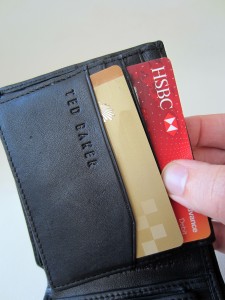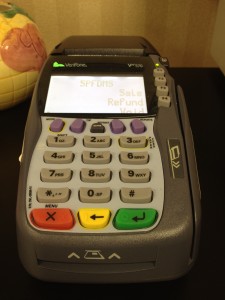November 8th, 2013 by Elma Jane
If you want to make the most out of your shopping adventures, you need to have a credit card that helps you save money. The question is, which option is better for you? Some people automatically think about store credit cards, and others go for cash back credit cards. Before you apply for a card, assess which type of card would be more beneficial for your personal needs.
Cash Back Credit Cards
The main perk to having a cash back credit card is the fact that you can use it anywhere. It still acts as a traditional credit card. The only difference is that you get rewards from the money you spend on it. The average cash back credit card offers 1% cash back on all purchases. Some may also pay an additional 2% to 5% cash back on select purchases made with the card. Example, the Citi ThankYou Preferred Card offers 2 reward points per $1 spent on dining and entertainment. Blue Cash Everyday card from American Express offers 3% cash back at supermarkets, 2% cash back at gas stations and 1% on all other purchases. You could earn a great deal of your money if you choose the right cash back card and use it correctly.
The problem with cash back credit cards is that the rewards structure can sometimes be confusing. The Discover It Card features an attractive rewards program, but its 5% cash back offer changes every three months. It may be on home improvement purchases during one quarter, but during another quarter, it may be applicable on purchases at gas stations and for holiday shopping. You have to keep up with the rewards calendar to get the most out of your credit card. You also have to consider any fees associated with your credit card. Some cash back cards on the market have an annual fee, and many have a slightly higher interest rate than the average card. Review the terms of any card you are considering for so you can pick the perfect one for you.
Store Credit Cards
Store credit cards are usually easy to apply for and just as easy to obtain. Some of them can be used like regular credit cards, and others have to be used at a specific store. For instance, the traditional Walmart credit card can only be used at Walmart, but the Walmart Discover card can be used anywhere Discover is accepted. You need to know this about your card before applying for it. Many people get a store credit card because they receive some type of introductory offer when they apply for one. You might be able to save 10-15% off your initial purchase, or you might get a certain amount of cash back after making your first purchase. These offers are designed to lure you into getting a card, even though you may never use it again. What you may not realize in the euphoria of the introductory offer is the very high interest rate you typically have on a store credit card.
When you start looking at store credit cards, consider what kind of rewards you can get and how those rewards are accumulated. Do they only come from purchases at that store, or do they come from any transaction? Are you required to use rewards in the store, or can you use them online? Does the card have an annual fee? You must go through this type of analysis before deciding if a store credit card is worth getting.
Are Cash Back Credit Cards Better Than Store Credit Cards?
In our opinion, yes. This isn’t because we’re biased towards cash back cards. We just like the idea that you can earn rewards wherever you make a transaction. You aren’t limited to one store, either in the way you spend money or the way you collect your rewards. In addition, store cards usually have a higher interest rate. With that said, there are people who benefit from store credit cards because they shop at those stores all the time. If you spend thousands of dollars a year at Lowe’s for your construction company, a Lowe’s credit card may provide substantial savings for your business.
Don’t get overly excited when you reach the checkout counter. That one-time savings on a store credit card may not be worth it in the end. Think over your shopping habits and see if a cash back credit card is more suited for your needs. If so, you have plenty of them to choose from.
Posted in Electronic Payments, Financial Services, Gift & Loyalty Card Processing, Visa MasterCard American Express Tagged with: %, accumulated, American Express, annual, assesses, average, beneficial, calendar, cash, cash back, checkout, credit cards, dining, Discover, earn, entertainment, fee, improvement, interest, lowe's, market, money, online, pay, points, preferred, purchases, quarter, rate, rewards, savings, shopping, store, traditional, transaction, walmart
October 21st, 2013 by Elma Jane
Good time for merchants to start noting how their provider is handling card company fee changes as well as any future rate and fee changes, especially if your contract will expire in 2014.
October 2013 Rate and Fee Increase Notices
Visa, MasterCard, and Discover Credit card companies generally make rate and fee changes in the April and October time frame, although they have also made changes at other times of the year. Inevitably, some banks and merchant account providers seem to take advantage of the card company changes by increasing or adding their own mark-ups and by pointing too much of the blame at the card companies for the increases. This time around isn’t much different than others and merchants have sent me some rate and fee increase notices that go well beyond any card company changes.
In understanding how your provider is handling the latest card company changes, keep in mind that there are two important changes for October 2013:
Discover introduced a .25 cent increase to all transactions.
MasterCard introduced a .25 cent increase to certain transactions.
Below are two examples of recent notices on the October changes. Understanding the above .25 cent changes, how would you rate these providers?
Notice 1: 0.02 Percent + $0.02 Increase
“MasterCard, Visa and Discover typically evaluate the Interchange rates and fees twice per year most often in April and October. Based on recent changes as well as analysis from other network providers and vendors, the following changes to your merchant account are being implemented and will be reflected in your merchant statements for transactions processed beginning in October:
Interchange Plus Merchants: Percentage charged in excess of Interchange will increase by 2/100ths of a percent; and
Transactions Fees for all authorized transactions will increase by $0.02/transaction.”
Tiered Pricing Merchants: Qualified Rate for Visa, MasterCard and Discover will increase 2/100th of a percent;
Notice 2: 0.40 Percent Increase
“Effective October 1, 2013, the discount rates charged for your Visa, MasterCard, and Discover (as applicable) credit card and non-PIN (signature) debit card transactions will increase by 0.400%. We have increased these charges based on a variety of factors, including recent Card Organization changes and our own pricing considerations. This change will appear beginning with your October month-end statement you will receive in November.”
Your Statements Now go back to the statements you received in August and September or any notices you received via mail and read the notice your provider posted for these changes. Did the provider announce the actual change or did it state something quite differently? If it’s the latter, make sure it adjusts pricing accordingly. Also, make sure you monitor your rates, fees, and notices going forward to determine the best long-term course of action. If the provider needs you to extend your contract to correct its overcharges, then there are probably bigger pricing issues and more assertive action required by you to investigate your overall processing cost.
EMV Capable Terminals
To reduce fraud in the U.S., the card companies are introducing cards that have a chip as well as the current magnetic strip. Chip cards are prevalent outside the U.S. and EMV — Europay, MasterCard, and Visa — established the technical standards for processing them.
Brick-and-mortar merchants should understand about EMV.
Brick-and-mortar merchants should have equipment capable of processing EMV chip card transactions by October 2015 as certain fraud liability will shift from the bank that issued the card to the merchant. The equipment may be a terminal or a chip card reader attached to the terminal or POS system.
Certain credit card transactions will require a PIN number instead of a signature similar to PIN debit transactions today. Also, like the current PIN debit devices, each chip reader will need to be encrypted and the encryption code is processor specific. Therefore, if a merchant has an encrypted device, changing processors may be more costly as the encryption cannot simply be downloaded over the phone or Internet as is done with terminal reprogramming now. Instead, the encrypted device will need to go back to the provider for encryption or swapped with an encrypted device or a new encrypted device may be needed.
“EMV capable” can mean very little. In fact, if you have purchased or leased an “EMV capable” terminal it may simply mean that it has the slot or contactless connection to place the chip card and the terminal may have the capability to eventually be encrypted to actually process chip cards. However, the cost and time required to do so could be prohibited.
However, merchants should be planning to have equipment capable of processing chip card by October 2015. In fact, they should be planning to have the equipment capable of processing chip cards well ahead of the October 2015 — perhaps as early as late 2014, to ensure receiving it in time.
If a merchant’s existing terminal fails or is no longer supported, the merchant should inquire about EMV terminals as a replacement. However, ask if it comes fully encrypted and capable of actually processing an EMV transaction or if it will need the encryption later. Right now, the answer is likely that the terminal will need encryption later. If so, the merchant should obtain the time frame, process, and cost for enabling the terminal to actually process chip cards. This should be in writing. Remember, new terminals cost the provider around $150 to $250 and the encryption may be an extra $25 to $50.
Make sure you are comfortable with your provider and have negotiated the best processing cost before changing to encrypted EMV equipment.
Merchants do not need EMV terminals today and very few providers actually have terminals that can process an EMV chip card transaction right now.
Posted in Credit card Processing, Electronic Payments, EMV EuroPay MasterCard Visa, Visa MasterCard American Express Tagged with: authorized, banks, chip card, contactless, cost, credit-card, debit, devices, Discover, EMV, encrypted, fee, increase, interchange, MasterCard, merchant account providers, network, overcharges, percent, percentage, PIN, POS, pricing, processor, prohibited, rate, rate and fee, statements, terminal, transactions, visa

